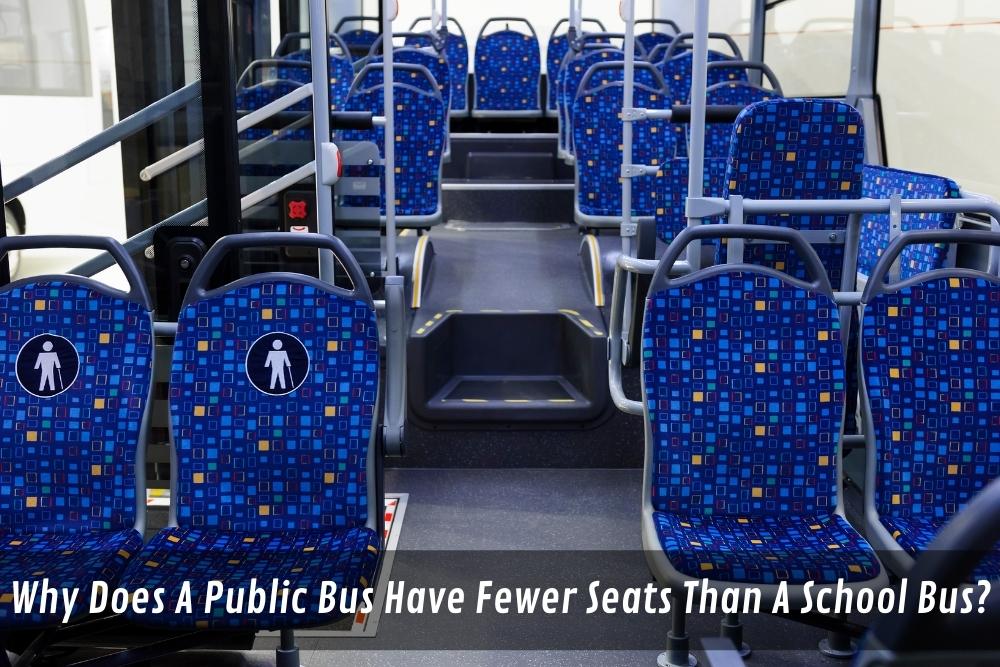Why Does A Public Bus Have Fewer Seats Than A School Bus?

When it comes to the bus passenger seat, some people wonder why public buses typically have fewer seats than school buses. After all, public buses are often larger and can carry more people. So, why not pack in more seats to maximise the number of passengers?
In this blog post, we will explore the reasons behind this difference and shed some light on why public buses have fewer seats than their school bus counterparts. We will look at various factors that influence the seating capacity of buses, including safety regulations, passenger comfort, and operational efficiency. By the end of this article, you’ll have a better understanding of why public buses are designed with fewer seats and how this benefits both the passengers and the transportation companies.
What is the difference in the intended use between a public bus and a school bus?
In Australia, the intended use of public buses and school buses is also different. This impacts the design and seating arrangements of these buses. Public buses are primarily used for public transportation, such as getting people to and from work or running regular routes around cities and towns. School buses, on the other hand, are used to transport students to and from school.
One significant difference between public and school buses in Australia is the seating arrangement. School buses usually have bench seats that can accommodate multiple students, while public buses have individual seats. This is because school buses are designed to carry a large number of students, and bench seats allow for more passengers to fit on the bus. However, public buses typically have fewer passengers, and individual seats provide more comfort and personal space for passengers.
Another difference is in the safety features required for school buses. In Australia, school buses are required to have high-visibility markings, flashing lights, and stop signs. This is to alert other drivers when the bus is picking up or dropping off students. They are also required to have seat belts, which is not mandatory for public buses. The use of seat belts on school buses to ensure the safety of students during transit.
In terms of bus driver requirements, both public and school bus drivers in Australia need to have the appropriate license and training. However, school bus drivers may require additional certifications and clearance, such as a Working with Children Check NSW.
In summary, while there are some similarities between the intended use and design of public and school buses in Australia and the United States, there are also significant differences based on the specific regulations and requirements of each country.
What are the regulations and safety standards for public buses?
- In Australia, public buses are subject to safety regulations and standards issued by the National Heavy Vehicle Regulator (NHVR). These regulations are designed to ensure the safety of bus passengers, drivers, and other road users.
- One of the key safety requirements for public buses in Australia is the installation of seat belts for all passengers. This includes both forward-facing and rearward-facing seats, and the use of seat belts is mandatory for all passengers. In addition to seat belts, public buses must also meet certain safety standards for seating. It includes seat design, spacing, and cushioning.
- Public bus drivers in Australia are required to hold a valid commercial driver’s license and undergo regular medical assessments. This is to ensure they are fit to drive. They must also comply with strict hours-of-service regulations to prevent driver fatigue and maintain safety on the road.
- The NHVR also sets standards for bus maintenance, inspection, and repair, which are designed to ensure that public buses are safe and roadworthy. These standards cover everything from brakes and tires to lighting and safety equipment.
In summary, the safety regulations and standards for public buses in Australia are designed to promote the safety and well-being of bus passengers and other road users. The use of seat belts, regular maintenance and inspections, and strict driver requirements are just some of the ways that the NHVR works to ensure that public buses are safe and reliable.
What are the factors that influence seating capacity?
In Australia, the factors that influence seating capacity on public buses include several key considerations.
- Firstly, safety regulations and standards play a significant role in determining the number of seats that can be installed on a public bus. This includes requirements for minimum aisle widths, emergency exits, and passenger capacity limits, which are regulated by government bodies.
- Secondly, the type and size of the bus also play a significant role in determining seating capacity. Large school buses, for example, often have bench-style seats that can accommodate multiple passengers. While smaller buses may have individual coach seats that are more spacious and comfortable.
- The seating manufacturer and transport seating design also influence seating capacity. With different designs and materials offering varying levels of space and comfort. Manufacturers must comply with Australian standards and regulations when designing and constructing seating for public buses.
- State regulations can also impact the seating capacity of buses. Some states require school buses to have specific seating arrangements or to install seat belts, which can impact the overall seating capacity of the vehicle.
- The weight of the bus is also a crucial factor, with vehicles over 10,000 pounds requiring a commercial driver’s license to operate. This can impact the size and seating capacity of the bus.
- Finally, individual states may have their own requirements for seating capacity on public buses. These may differ from national standards set by bodies such as the National Highway Traffic Safety Administration.
In summary, the factors that influence seating capacity on public buses in Australia are complex and varied. Safety, practicality, and passenger comfort all play significant roles in determining the number and design of seats.
Have you ever considered how crucial it is for public bus riders to have comfortable seating?
Comfortable seating is crucial for public bus riders, whether they are travelling on school buses, public transport buses, or coaches. The bus passenger seat design can have a significant impact on the rider’s overall experience, as a comfortable seat can make a long journey much more pleasant.
In the case of school buses, the seating arrangement often consists of bench-style seats that can accommodate multiple students. While these seats are designed to be sturdy and safe, they may not always provide the most comfortable ride for students who have to sit for extended periods.
Public transport buses and coaches often have individual seats with cushioning and adjustable features that can enhance comfort. The design of these bus seats can vary, depending on the intended use of the bus and the preferences of the manufacturer.
In recent years, there has been an increasing emphasis on the importance of providing comfortable seating for public bus riders. This has led to innovations in the bus seat design. It includes the use of ergonomic materials and the inclusion of additional features such as armrests, headrests, and lumbar support.
Not only does comfortable seating make for a more enjoyable ride for passengers, but it can also have practical benefits. It can reduce the likelihood of passenger discomfort or injury. It can also lead to improved rider satisfaction and increased ridership.
Overall, comfortable seating is paramount for public bus riders. Regardless of whether they are travelling on a school bus, public transport bus, or coach. A well-designed and comfortable bus passenger seat can make all the difference in creating a positive rider experience. This is especially true on long-distance buses, where riders may spend hours seated in the same position. Knowing the best and worst seats on a long-distance bus can also impact a rider’s experience, making it crucial for seating to be designed with comfort and practicality in mind.
Contact Sege Seats today for all your bus seating needs. We understand how important it is to have comfortable seating for public bus riders. That’s why we specialise in providing high-quality bus passenger seat that combines superior comfort with stylish design. From school bus seats to coaches, our seats are designed to provide maximum comfort and support while meeting the needs of each unique transportation system.





